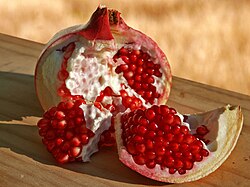 In Roman Mythology, Persephone loved the seeds of the pomegranate fruit so much that their flavor and allure were the ruin of her. It is said that the fruit caused Pluto the ability to overpower Persephone and never again could she return to earth. This prevention of the Goddess Persephone to return to the earth was the cause of winter. We who love snow, skiing and ice–skating can (in a mythological and theoretical sense) thank the pomegranate. Thank you, Pomegranate, for indirectly creating this cold, sporty, and snowy, pillowy season!
In Roman Mythology, Persephone loved the seeds of the pomegranate fruit so much that their flavor and allure were the ruin of her. It is said that the fruit caused Pluto the ability to overpower Persephone and never again could she return to earth. This prevention of the Goddess Persephone to return to the earth was the cause of winter. We who love snow, skiing and ice–skating can (in a mythological and theoretical sense) thank the pomegranate. Thank you, Pomegranate, for indirectly creating this cold, sporty, and snowy, pillowy season!It is a wonderful thing to get a present from someone that is exactly what you like. Similarly, it is great to give someone exactly what they want. Usually, someone who likes to cook may be very interested in recipes and food arranged with care in a beautiful gift basket. With fresh fruit you can include recipes for relishes, sauces, tarts, pies, pastries, and creams – you can even give a gift basket designed to include tropical fruits.
So, perhaps you will want to look for a tropical fresh fruit basket when you consider what kind of present to purchase for anyone who is a culinary enthusiast. The fruits you include in you basket will not only be fresh fruits, but the tasty, sweet surprise of fresh tropical fruits; tropical fruits such as the pomegranate are very popular.
Pomegranate fruits are labor – intensive, with the thickness of their skin that results in their simple, durability and transportability. The fruit originates in the Middle East. It has been told that the Moors brought and introduced pomegranates to Spain, where the fruit actually, subsequently, became their national emblem.
A pomegranate grows on a very spine – like shrub. The fruit is round, it is a reddish – gold, and healthy pomegranates measure between two to five inches in diameter. They are distinguished by a crown – like tip, which is actually the base of the fruit, or the blossom’s end. The taste of their crunchy, juicy, seeds or kernels inside is often irresistible, as well as inspirational. Pomegranate has a wonderful flavor that appeals to many culinary artists.
The pomegranate kernels are surrounded by a creamy – colored outer membrane, which is bitter and not edible. To remove the seeds, first you must cut the blossom end and you will have to remove some of the white pith – however, do not break the red pulp that surrounds the seeds. It is recommended that you score the skin into approximately four segments. Break the fruit into halves, then break those halves into halves following your score – lines.
To remove the seeds bend back the rind of the pomegranate and simply scoop them out. If you are not a big fan of seedy stuff, you may want to doctor the fruit by extracting the juice for sauces etc. With a good juice extractor or strainer – the juice of just about any fruit can be removed without any seed sediment or large pulp.
A pomegranate will make a beautiful, surprisingly, tropically tasty icing, dressing for salads, a wonderful addition to a chutney or tropical relish, pink sorbet, even great pomegranate pudding recipes are even out there and available for you to try!

















No comments:
Post a Comment